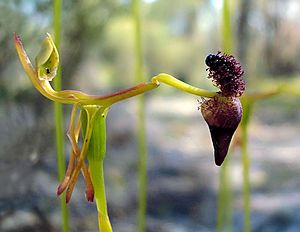Glossy-leaved hammer orchid facts for kids
Quick facts for kids Glossy-leaved hammer orchid |
|
|---|---|
 |
|
| Conservation status | |
| Scientific classification | |
| Genus: |
Drakaea
|
| Species: |
elastica
|
The Glossy-leaved hammer orchid (Drakaea elastica), also known as the praying virgin, is a special type of orchid. It grows only in the south-west part of Western Australia. This orchid is like other "hammer orchids" because it uses a clever trick to get pollinated. It pretends to be a female wasp to attract a male wasp!
The orchid's special lip, called a labellum, looks and smells just like a female wasp that cannot fly. This tricks the male wasp into trying to mate with the flower, which helps the orchid spread its pollen. The glossy-leaved hammer orchid was the first of its kind to be discovered and named. It is now considered "endangered" by both the Australian and Western Australian governments, meaning it needs special protection.
Contents
What the Glossy-leaved Hammer Orchid Looks Like
The Drakaea elastica orchid has a single leaf that sits close to the ground. It also has an underground tuber, which is like a storage part for food. The leaf is shaped like a heart and is about 20 mm (0.8 in) wide. It is smooth, light green, and shiny. The veins on the leaf are a bit darker.
The leaves usually appear in July or August. However, by the time the flower opens, the leaf often starts to dry up. The flower stem can be 12 to 30 cm (4.7 to 12 in) tall. Each single flower has a short stalk, about 10 to 12 mm (0.39 to 0.47 in) long.
The Flower's Clever Disguise
The flower of the glossy-leaved hammer orchid looks like a female thynnid wasp, specifically one called Zaspilothynnus gilesi. You can tell this orchid apart from others because it does not have a spine on its column (the central part of the flower).
Other hammer orchids, like Drakaea glyptodon and Drakaea concolor, also lack this spine. But you can tell them apart because D. concolor has a dark green leaf, and D. glyptodon has very clear veins in its leaf.
The back sepal (a leaf-like part of the flower) is about 12 to 15 mm (0.47 to 0.59 in) long. The two side sepals and the petals are each about 12 to 14 mm (0.47 to 0.55 in) long.
The orchid's labellum, which looks like an insect, has a "head" part that is about half the length of its "body." This "head" is light-colored and has hairs on most of it. The rest of the labellum, which looks like the female wasp's "body," is light green on the top half with a few dark spots. The bottom half is a dark maroon color. These beautiful flowers bloom from late September to early November.
How it was Named
The Drakaea elastica was first officially described by a person named John Lindley in 1840. He wrote about it in a book called A Sketch of the Vegetation of the Swan River Colony.
Sometimes, this name has been mistakenly used for other hammer orchids. For example, it was once confused with the more common warty hammer orchid (Drakaea livida). The second part of its scientific name, elastica, comes from an Ancient Greek word elastikos, which means "elastic."
Where it Lives
The glossy-leaved hammer orchid is found in only a few places in Western Australia. These areas are near Cataby and Busselton, within a region called the Swan Coastal Plain.
It likes to grow in deep sand in woodland areas. You can often find it in low-lying spots near temporary swamps.
Protecting the Glossy-leaved Hammer Orchid
The Drakaea elastica is known to exist in 42 different locations. However, most of these places have fewer than 15 plants. Only one location has about half of all the known individual plants.
Because of this, the Western Australian Government's Department of Parks and Wildlife calls this species "threatened." This means it is likely to become extinct, or it is very rare and needs special protection. The Australian Government also lists it as "vulnerable" under the Environmental Protection and Biodiversity Conservation Act.
The main dangers to this orchid's survival include:
- Weed invasion: Other plants, like weeds, can take over its habitat.
- Recurrent fire: Fires happening too often can harm the plants.
- Dieback disease: A plant disease that causes parts of the plant to die.
- Rubbish dumping: People leaving trash in its habitat.
- Illegal vehicle usage: Vehicles driving where they shouldn't, damaging the plants.


